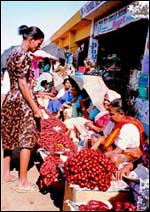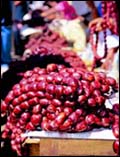


 Veteran Ad. Man and Foodie FRANK SIMOES believes the Goa Sausage is a gift from the Gods.
Veteran Ad. Man and Foodie FRANK SIMOES believes the Goa Sausage is a gift from the Gods.
|
|
Sausage supremacy is a gift from the Gods.If today the Goa sausage hovers over the Goan kitchen like some benign divinity, there is reason. From plump, marbled rump to lean and succulent rib, testimony to a triumphantly imaginative appetite, our noble porker reincarnates into a sausage of exemplary virtue. Hoofing it over such squealing pretenders as the dour, flavourless Cumberland (typical British hogwash), the Spanish chorizo (all chilli and no soul), the overly ballyhooed Italian pepperoni (Mamma Mia! just about sums it up), the American frankfurter (now you know where that sad allusion "a pig in a poke" came from) and the blustering German wiener (which prompts the grim reflection, what good is length without performance?).
The best things in life begin with hearth and home. When I observe the tender loving care bestowed on a pregnant sow in our village by her owner, I am reminded of literature�s most famous love affair between peer and pig, Lord Blandings and his Empress, recorded by P.G. Wodehouse with the reverence that grand passion deserves. Small beer, as far as our local porker is concerned. What could be more demeaning than confining a pig to a pen? And mere size is no substitute for chutzpah. In Goa we produce a porker which pays delicious tribute to the good things of life home-made mash (a rich porridge of rice and left-overs) and inventive snacking at large wherever tantalising smell calls to investigative snout � under bushes, behind beach shacks, in the mangroves, at friendly kitchen doors. An abundance of fresh air. Lots of hungry sex. And regular infusions of hi-octane adrenaline involving close encounters with bad-tempered goats, feral cats, dogs of mean disposition and gangs of little boys with sticks who seem to have nothing better to do in life than chase piglings up hill and down dale. But the exercise is good for body and soul; it sends the blood coursing to every last extremity and makes for a bigger, fatter, tastier porker. Such is the distinguished pedigree of the Goa sausage. Infused with a dash or two or more of vintage caju feni to provide, shall we say, a certain spiritual elevation.
In Bombay the Goa sausage has its pretenders. The over-spiced, under-flavoured Bandra sausage, the sad-sack Dhobi Talao sausage, other unsavoury offerings from Marve, Bassein and points North. No contest. They are to the true Goa sausage what Hong Kong Scotch is to a Highland Single Malt, or the inferior white Italian truffle to the black gold found only in France, or Californian plonk to a white Burgundy Grand Gru. The finest things in life are immutable. Thus, the Goa sausage may only be celebrated in Goa and nowhere else on the planet. Praise the Lord and pass the feni! But in Goa, as in Burgundian vineyards, you will find serious, learned debate over the virtues of the Goa sausage from Saligao and its distant cousin resident in Benaulim. I am on intimate terms with the Saligao sausage as I should be (my maternal village) and can vouch for sterling worth. Full-bodied and of impressive length, it is twice the size of the Benaulim fledgling, and the highest order of care and commitment is lavished on its preparation.
Millimetric attention is paid to the size of the chunks of meat, and the proportion of meat to fat. Meat from rump and undercut is best, finely marbled, with one-third of firm white fat attached to each piece. Given the long hard haul ahead (six months from finished sausage to plated sausage), the quality of meat is of prime importance. Sea salt is rubbed in and the pork is set aside for a day. Then it is washed and dried in the sun. Goa�s celebrated red chillies, turmeric, garlic, ginger, pepper corns, cloves and cinnamon are stone-ground to a thick paste in sugarcane vinegar. The finest caju feni is solemnly infused. An enthusiastic blending of pork and paste follows. The sausage meat is carefully spooned into four inch lengths of tripe casing and knotted. The sausage strings, each two feet long, are laid out in concentric circles on reed mats and dried in the sun for a week. If you think you can now hog, lie down till the feeling goes away. The Goa sausage odyssey has just begun. The sausages are transported to the kitchen and hung from the rafters, a veritable merriment of plump, glistening promise, above the kitchen fires to cure. This takes six long months and tries one�s patience to the limit.
In the smoking lies the secret of the Goa sausage�s unique flavour and the reason why imitators cower in sackcloth and ashes. The traditional Goan cooking range consists of laterite bricks piled two high on either side of a wood fire. All cooking is done in earthernware pots. Woodsmoke filtered through unglazed earthernware adds just a hint of smokey flavour to the food and all of that lovely, unforgettable aroma is absorbed by the Goa sausages hanging above for six l-o-n-g months. At the end of it all, cruel and unusual punishment is inflicted on the Goa sausage. It shrinks and shrivels, develops geriatric lumps and creases, becomes dark and mottled as if stricken with a terminal disease hitherto unknown to medical science. At this stage the Goa sausage, now ready to be cooked, prompts grave misgivings in the uninitiated. Will one live to tell the tale?
|

Home Page
About the mag
Subscribe
Advertise
Contact Us

